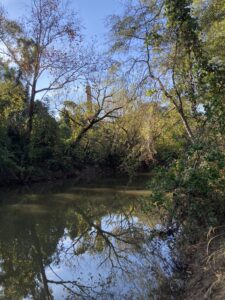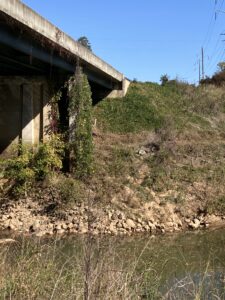Oconee River Isotope Project (ORIP)
Co-PIs: Alex Heri, Mike Marshall, Katie Reinberger
Water quality and environmental monitoring programs in rivers typically involve only one or two scientific disciplines to assess changes through time. However, rivers represent the integration many processes occurring in basins including geologic (e.g. weathering), hydrologic (e.g. precipitation) and biologic (e.g. metabolism). We recently initiated a project using an integrated approach to monitoring river systems that incorporates indicators of multiple disciplines through water-associated stable isotopes, including Strontium, water-Oxygen and Dissolved Organic Carbon.
Strontium: As a largely biologically conservative tracer in freshwater systems, strontium isotope ratio (87Sr/86Sr) will provide the geologic baseline of the monitoring reflecting the mostly physical and geochemical processes that occur in river basins.
Oxygen: Water oxygen isotopes (18O/16O) are largely driven by hydrological patterns and temperature variation and could help indicate otherwise unnoticed environmental changes and trends against the Sr backdrop.
Carbon: Dissolved organic carbon isotopes (DO13C) represent the largely biological component of the monitoring. DO13C can be affected by both terrestrial organic carbon supplies and subsequent in-stream processes (e.g. primary production and community respiration).
Project Status – 5/9/2024
We have completed 3 monthly sampling trips to 2 Athens-area rivers, North Oconee River (NOR) at MLK & Ruth and Middle Oconee River (MOR) at Atlanta Highway. Both sites are directly adjacent to USGS hydrologic monitoring stations (02217770 & 02217500) that continuously document river discharge and other useful variables. We have secured access to MOR via Big Dogs on The River and regular use of a multimeter probe from UGA’s River Basin Center to measure common hydrological covariates.
Multimeter Data Summary
Data collected using a multiprobe included water temperature, pressure, %DO, DO, SPC (Specific Conductivity), conductivity, and pH. This data was supplemented by USGS data on gauge height and discharge. The NOR and MOR had similar temperatures with the temperature increasing on average 2.9 degrees Celsius per month. Pressure across both sites were similar with an average increase of 2.8 mm Hg per month. The MOR had a slightly higher %DO compared to the NOR. There was a slight decrease of –0.8 per month in [DO] (mg/L) across both sites. MOR had a higher SPC (us/cm) and C (us/cm) compared to NOR which could suggest a higher amount of dissolved material at the MOR. The average pH was the same for both MOR and NOR at 7.2. NOR had a higher gauge height according to USGS data. The average discharge (ft³/s) was higher at MOR versus NOR.
Isotopic Analysis Status
Water samples have all been refrigerated or acidified as appropriate for each analysis. Aliquots have been freeze-dried and acidified to remove inorganic carbon in preparation for the dissolved organic carbon isotope analysis within the next week. The new TCEA-IRMS system is fully plumbed and initial testing and tuning is underway for the water-oxygen isotope analysis. Samples are also in the queue for strontium isotope analysis with initial results anticipated in time for the next status report in September.
Project Status – 9/9/2024
We have completed 4 more monthly samplings at our 2 focal sites in Athens and 3 additional opportunistic samplings in the catchment headwaters and precipitation. We also made tangible progress on dissolved organic carbon isotopes (DO13C) analysis and 18O-water isotope instrumentation and preliminary testing.
Multimeter Data Summary
Data collected using a multiprobe included water temperature, pressure, %DO, DO, SPC (Specific Conductivity), conductivity, and pH. This data was supplemented by USGS data on gauge height and discharge. The pH at Middle Oconee River (MOR) was slightly higher than North Oconee River (NOR) on average. NOR had a higher Specific Conductivity (SPC) and Conductivity (C) both given in micro-Siemens per centimeter (µs/cm) compared to MOR, suggesting a higher amount of dissolved material at NOR. This contrasts with the spring 2024 ORIP samples where MOR had higher levels of conductivity. MOR had a consistently higher summer discharge than NOR. The pressure at MOR and NOR were similar throughout the summer. MOR had a higher dissolved oxygen (DO) compared to NOR throughout the summer. On average, DO continued to decrease across both sites, with a slight increase in the last month of sampling (8/26/2024). The temperature at MOR was slightly higher than NOR.
Isotopic Analysis Status
Dissolved organic carbon isotopes (DO13C) have been analyzed for the first 3 sampling dates this spring for both focal sites. Average DO13C from February through April 2024 in NOR and MOR were both -27.74 per-mil, but with slightly higher variability in MOR (+/- 0.77 SD) than NOR (+/- 0.31 SD) over that 3-month sampling period.
Optimization of the 18O isotopic analyses is currently in progress, but provisional 18O-water results from the first sampling at each focal site display distinct differences between the sites. The 18O-water in February 2024 at NOR was considerably lower (-19.36 per-mil) than MOR (-16.05 per-mil), suggesting that 18O-water may be a sensitive indicator of differences between the hydrology of these two adjacent river catchments.
We also began testing hydrogen water isotope (²H-water) of a few ORIP samples including a sample of Middle Oconee groundwater from the Statham City Spring and a rainwater sample collected at CAIS in June 2024. These two samples represent two potential endmembers for mixing in the river waters. Preliminary ²H-water results suggest groundwater supplying the MOR catchment is notably more depleted in deuterium (-51 per-mil) than precipitation (-41 per-mil). Two focal site samples collected in February both fall within this range with NOR at -47 per-mil and MOR at -45 per-mil, suggesting water hydrogen isotopes may also be an informative indicator of water sources for both catchments.
Other ORIP Progress
Water samples for Sr isotope analysis have been chemically processed and are ready for analysis. Due to the low Sr concentration in these river waters, samples must be analyzed in dry-plasma mode. Data acquisition will take place within the next two weeks and results, including preliminary data from light isotope analysis, will be presented by A. Heri at the annual meeting of the Geological Society of America (GSA) at the end of September 2024.
In addition, we hired a student assistant to help with ORIP and related efforts in August 2024. The student has already taken part in fieldwork for the August sampling of the two focal sites and started working with M. Marshall. The student will take turns in the different PI’s labs based on need and interest.
Table 1 – ORIP Summer 2024 Multimeter and USGS data.

Heri et al 2024 GSA – ORIP Poster Presentation
NOR site photos:


MOR site photos:






